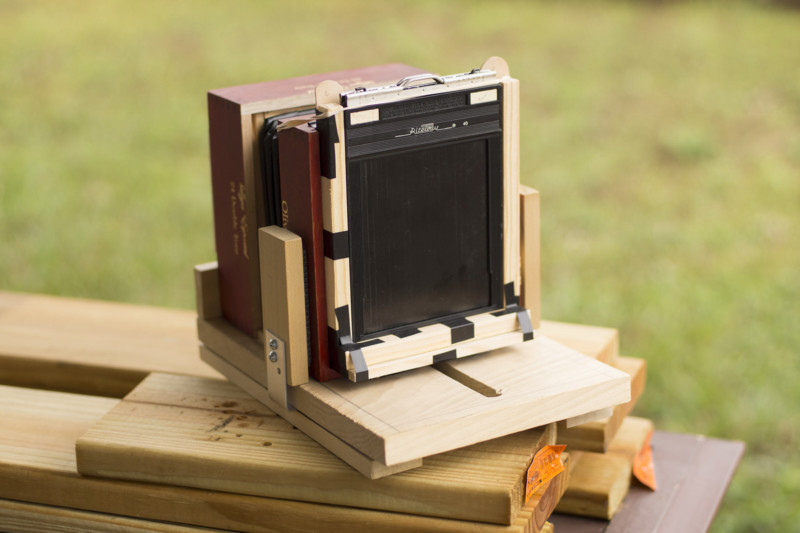I Built Myself a Simple and Thrifty 4×5 Camera
![]()
My name is Richard Evans, and I recently built myself a 4×5 camera. Here’s a look at the camera and what I did.
I don’t know a single thing about woodworking or building anything, so much of this camera looks pretty ugly, but I did my best to copy components I noticed were on actual view cameras.
![]()
I made the bellows from construction paper and faux leather cabinet liner stuck together. I tried to make this camera as modular as possible, so that meant using as little glue as possible. For example, I attached the bellows to the body with velcro, and used only the friction of other wooden pieces I cut to hold other components in place.
![]()
Since I don’t know much about these matters, I didn’t want to commit to drilling a hole or gluing a piece unless I was absolutely sure it was needed.
My “ground glass” view screen for this is an oatmeal container lid. I noticed it was opaque and thought it might work.
![]()
It works!
![]()
I cut it down to the approximate height that the film plane would be on.
These two thumbscrews are attached to the front and rear standards.
![]()
However, only the rear is meant to move for focusing. You can simply tighten the screw when you want to hold a focus position.
Something I hadn’t considered until now unfortunately is the issue of where to put a tripod mount and how that might affect the function of these two screws. Oh well! Just another problem to solve.
![]()
![]()
The red wood parts are a cigar box. That’s what I started with because it had a sliding lid and I thought that function might be a useful means of creating different backs for the camera that could simply slide into place.
![]()
The back I created fits into the grooves for the cigar box lid.
![]()
This is one of the backs I made for the camera. I also made one with an actual ground glass, as well as one for wet plate (I hope).
It’s in pretty rough shape and all taped up because I made a lot of mistakes with this but didn’t quite want to scrap it and start over.
Here’s the inside of the camera:
![]()
The lens is a 7″ Kodak Ektanon from a Kodak carousel slide viewer I found at a thrift store. I had to prop up the rear of the lens as you can see because I noticed it was sagging a bit (an issue when your lens board is made of paper).
Also, there was probably a good 1.5 inches of plastic sticking out beyond the back lens element that I sawed off with a hacksaw because I hoped it would provide a better circle of coverage.

There’s no shutter on the lens, so I knew I needed something if I was going to shoot film. I estimated the working aperture of this lens to be something around f/1.5. That’s some shallow depth of field!
![]()
I attached a wood sandwich to the front over the lens and made a sliding curtain shutter of sorts that would fit through it.
![]()
I got to thinking how your average SLR has a curtain that moves horizontally, and so I wanted to try and imitate that with my design.
It’s a simple mechanism and there’s definitely no way of knowing the shutter speed with each pull or any way to produce a constant result, but I think it should work fine. You can actually pull it pretty quickly and I’d guess it would rival 1/1000th of a second.
I figured it’ll take some trial and error, but I can always adjust the width of the slit if I need to drastically change the speed.
I’ve been toying around with homemade large format cameras lately, and it’s so enjoyable experimenting! Plainly stated, I am fascinated by analog photographic processes and the science of it all, and I hope to continue learning and building cameras!
P.S. I don’t have any good example photos to share yet, but I’m planning to shoot some when I get the tripod I’m saving up for and will update this post then.
About the author: Richard Evans is a photography enthusiast who started in digital, expanded to film, and now spends time building his own cameras. You can find his photos on Instagram.